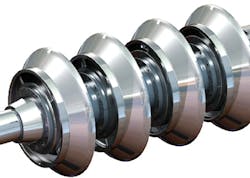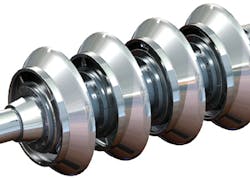Subsea multi-phase pump targets doubled power, improved gas/liquids handling
Jeremy Beckman
Editor, Europe
Aker Solutions has developed a new multiphase pump designed to push the boundaries of subsea boosting. The company is leading the MultiBooster development under a joint industry project supported by three majors as initial partners, with a further three becoming involved in the final complete system test phase.
Prior to 2011, when planning for the development started, Aker Solutions had, with various sub-vendors, engineered and supplied subsea multiphase pumps for two projects, CNR’s Lyell field in the UK northern North Sea and BP’s King field in the Gulf of Mexico.
But the company decided a new approach was needed to increase the multiphase capacity and differential pressure (dP) generation, and that this would be best served by having full control over the system’s core components. It then drew up plans for a development program focused on the multiphase pump and motor, condition monitoring and qualification testing, with the aim of creating a modular platform that could fit all applications. It invited various offshore operators to support a JIP, with the program getting under way in late 2012. Based on feedback from the operators, the agreed goals were to increase pump and motor speed and power from the then limits of 4,000 rpm to 6,000 rpm, and 3 MW to 6 MW; to double liquids/gas handling capacity to 1,500 cu m/hr (52,972 cu ft); and to substantially increase the dP at a high gas volume fraction (GVF).
According to Aker Solutions Business development Manager Marco Gabelloni: “Some of the partners saw this as an opportunity for boosting of deeper-water and long-distance tiebacks – that’s how we came up with the 6 MW target – while others wanted more competition in the market, with only a few multiphase pump suppliers to choose from.” Since the program started, and the subsequent oil price decline, the industry’s priorities have veered more toward brownfield applications. “Many operators now do not want to invest in large new field developments,” Gabelloni explained, “but rather to use this technology to help them extend the lives of their existing facilities by tying in new wells.
3D rendering of the pump shaft showing Aker Solutions semi-axial impellers. (Courtesy Aker Solutions)
“Since 2012, the JIP members have provided financial assistance, and more importantly, their technical expertise. Based on their experience in previous subsea pump projects, they were able to provide valuable feedback on the system’s various requirements.”
Aker Solutions built a test facility at its R&D complex in Tranby, Norway, to qualify the motor and demonstrate the pump’s capability to run at 6 MW. It includes a multiphase test loop constructed from duplex stainless steel with a design pressure of 63 bar (914 psi). The closed loop arrangement features a large separator, compressor, multiphase cooler, Coriolis flow meters with piping/valves to connect with a deep test pit for comprehensive pump-motor testing, and a maximum multiphase flow of 1,500 cu m/hr (52,972 cu ft/hr) with water and air, or nitrogen and model oil.
The impellers and motor have been the most critical elements of the project. Multiphase impellers are typically of a helico-axial design, but based on previous experience, the JIP opted to develop a mixed-flow impeller in which the flow channel was part-axial and part-radial, using the centrifugal action to deliver more pressure generation from each impeller. The resultant ‘helico-mixed flow’ design involves closed impellers with backflow leakage throttled through an impeller ring to reduce the total backflow. Results were encouraging from two tests during 2013-14 of two-stage impellers and diffusers in a pilot pump, with pressure generation and multiphase pumping efficiency as predicted. “From this,” Gabelloni said, “we were able to extrapolate what would be the actual field pump performance in order to validate computational fluid dynamics (CFD) models.”
The next priority was to design, construct, and test a full-size prototype pump capable of generating 100 bar (1,450 psi) differential pressure at 70% GVF, with appropriate shaft and bearing sizes to ensure rotodynamic stability at speeds up to 6,000 rpm. The chosen design was an eight-stage pump, with the number of stages adjustable to suit the required differential pressure, and a back-to-back impeller arrangement to allow the system to withstand impeller thrust forces. To provide the power needed for longer step-outs, the partners opted for a subsea induction motor. Aker Solutions also developed Class H FEP cable providing the insulation needed for the motor windings to withstand the higher operating temperatures associated with 6 MW pumping power.
Testing to date on the Tranby loop has proved the system’s capability to handle flow rates of 1,500 cu m/hr (over 200,000 b/d) and the ability to handle high GVF by exceeding 150 bar dP at 70% GVF: “This is substantially above what we had anticipated,” Gabelloni said. Tests have also proven the operation of the subsea motor, which uses a mixture of water and glycol as a lubricating and cooling medium. A complete pump/motor system test is currently in progress, the aim being to confirm the system’s full operating envelope. In future, the facility at Tranby will also be used for factory acceptance tests, he added.
Another innovation is the use of new proximity probes for providing continuous measurements of the rotor displacements, with analysis of the data to determine when the pump should be retrieved for maintenance. The probes, positioned close to the motor/pump bearings inside the casing, each comprise one axial and two radial sensors, and are being qualified for 1,034 bar (15,000 psi). “No one else can provide this capability,” Gabelloni claimed. “It allows us to accurately track the pumping system’s performance, especially when close to the boundaries of its operating envelope.
“This new pump module has a standardized modular design, sharing several components with our LiquidBooster single-phase pump. It is designed to be installed through the installation vessel’s moonpool, even in the most challenging weather, and to be easily retrieved.”
Reference: ‘Profit Increase with new Subsea Boosting Products’, presented by Age Hofstad and Hans Christian Nilsen of Aker Solutions at OTC 2017, organized by the Society of Petroleum Engineers.

